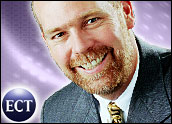
As Wall Street unwound last week, RightNow CEO Greg Gianforte watched from a vantage point an ocean away. As it happened, he was in London, making a stop on his self-assigned global tour to visit the company’s top 50 users.
Like many people, Gianforte is viewing the events with a combination of uncertainty and cautious hope that the turmoil has reached its peak and the U.S. economy will now begin to stabilize.
In one respect, though, he feels like he has been down this road before. RightNow survived the dot-com bust, which he now views with a glass-half-full mentality.
“We were fortunate — we started off during the first part of this decade, so we have experience in operating during down periods,” he told CRM Buyer.
It has become second nature for the company to prove to its prospective clients that its product line ultimately will save them money, he said.
With that background in place, the company is largely sticking to its already-established, long-range product development and corporate growth plans, which Gianforte shared with CRM Buyer in an exclusive interview.
CRM Buyer: Why this shift in your day-to-day activities — by that I mean your focus on visiting customers?
Greg Gianforte:
I changed my role in January. I am still CEO — but with Susan Carstensen as our new COO, I have been able to free up my schedule. So I have been spending a good portion of my time visiting customers. I’ve done 170 visits this year so far. I like it — it gives me a good sense of the issues our customers are facing. We have about 1,900 customers around the world — my goal is to visit the top 50.
CRM Buyer: Besides a first hand impression of your customers’ issues, what do you gain from these visits that a sales rep couldn’t convey to you?
Gianforte:
Well, when I show up, we meet at a higher level in the organization, and that changes the nature of the discussion. For instance, with one client we had been dealing with the VP of customer care, who reported to an SVP who reported to an EVP. When I came to visit, we met with all three levels of management. Also, I’ve picked up things that help us in our own operations. For instance, one customer had developed a quarterly review process with its own customers — a great idea, I thought. So we are rolling it out worldwide to our own customers.
CRM Buyer: What are you hearing right now from your customers?
Gianforte:
Especially recently, there has been a big focus on cost reduction. We’ve been hearing increased frustration with traditional big iron software deployments. I believe that the recession — or potential recession — will accelerate the switch to SaaS (Software as a Service) and, in fact, we are already starting to see that. IT budgets and projects are focused more on cost reduction, and there is less availability for big bang implementations.
We are also seeing customer experience projects come to the forefront as the economy softens. Companies want to drive costs out of the business, yes, but they also need to keep existing customers as they do so.
CRM Buyer: Can you tell me a little about your project development pipeline? What can users expect to see from you over the next few years?
Gianforte:
First, continued best-of-breed in e-service, including Web self-service, chat and e-mail management. That is our calling card. We are continuing to invest heavily in those areas.
For example, in August we introduced guided assistance — a case-based diagnostic tool on the agent’s desktop that leverages the knowledge base. In the future, we plan to expose that tool as part of our self-service capability, so end users can take advantage of the same diagnostic decision tree through the customer portal.
A second category of focus for us continues to be the contact center. We have added features like contextual work spaces, guided assistance and proactive chat. We plan to continue to focus on turning this service component into a de facto sales operation. It’s funny — traditionally, customer service operations try to get people off the phone, while sales operations try to get them on the phone. Future investments you will see will include more advances around agent scripting, cross-sell, upsell and advisory functions.
The third area of focus is around what we are calling “consumer-centric CRM.” Enhancements in this category fall into three areas. One is increased segmentation — consumer-oriented businesses have so many customers they have to break them into segments. We are adding capabilities to automate that process.
We are also adding capabilities for automated personalization. In fact, there will be a whole set of new initiatives around that. The third subcategory in consumer-centric CRM is social networking. We already have a partnership with Lithium that has been very successful. We will build some technologies around this functionality, as well as add to our partners. The challenge in this area is that there are a lot of social networking developments out there, but they don’t have a direct benefit to a customer care operation. So we have a tight filter in determining what we will do here.
The fourth category of focus for us is integration and building out our ecosystem. We are continuing to work with systems integrators and tech partners to make sure we can connect all of the dots integration-wise.
CRM Buyer: Obviously, you are spending a lot on Research & Development right now. Can you quantify this investment?
Gianforte:
A lot depends on where we are in our product development cycle. Right now, we are investing heavily in the e-service area. I would say about 40 percent of our R&D budget is going into this technology. Two years ago, we were spending more on contact center functionality as we readied our 8.0 release. We spent about (US)$40 million over three years developing our agent desktop. I would say we spend about 12 percent to 13 percent of our revenue on R&D, on average.
CRM Buyer: Any thoughts on what the economy will mean for the CRM industry in general?
Gianforte:
Well, if they weren’t already, big bang, all-inclusive CRM projects are now dead. The CRM getting deployed today is much more modular and directly targeted at cost reduction — vendors should be expected to prove the worth of a solution before a company spends any money on the software.






















































